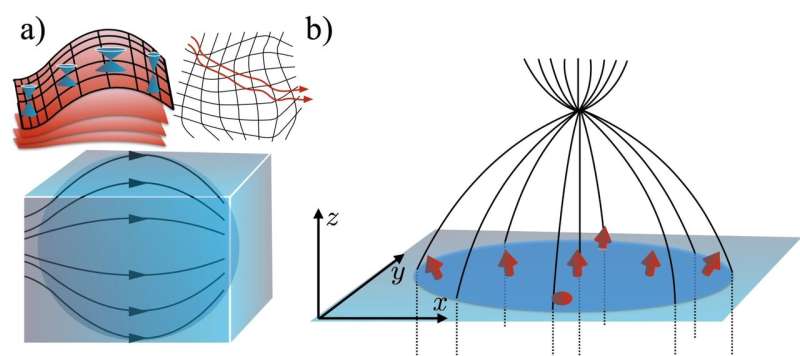New quantum materials offer novel route to 3-D electronic devices

Researchers have shown how the principles of general relativity open the door to novel electronic applications such as a three-dimensional electron lens and electronic invisibility devices. In a new study funded by the Academy of Finland, Aalto University researchers Alex Westström and Teemu Ojanen propose a method to go beyond special relativity and simulate Einstein's theory of general relativity in inhomogeneous Weyl semimetals. The theory of Weyl metamaterials combines ideas from solid-state physics, particle physics and cosmology and points a way to fabricate metallic designer materials where charge carriers move like particles in curved space-time.
The researchers propose Weyl metamaterials, a generalisation of Weyl semimetals, that enable new types of electronic devices through geometry engineering.
"The systems we introduced offer a route to make the charge carriers move as if they were living in a curved geometry, providing a tabletop laboratory for simulating curved-space quantum physics and certain cosmological phenomena," Alex Westström explains.
Weyl semimetals are an example of recently discovered quantum materials that have received a lot of attention. Charge carriers in these materials behave as if they were massless particles moving at the speed of light.
"We discovered that Weyl metamaterials may serve as a platform for exotic electronic devices such as the 3-D electron lens, where the trajectories of charge carriers are focused much like beams of light in an optical lens," Teemu Ojanen says.
The electric conduction in Weyl semimetals reflects the physics of Einstein's special theory of relativity. Nevertheless, special relativity also assumes an absence of gravity, which Einstein formulated as a geometry of space-time.
The theory of Weyl metamaterials also paves the way for fundamentally new electronics applications, for instance, the development of electronic invisibility devices. The key idea behind the potential applications is an artificially created curved geometry, which bends the motion of charge carriers in a controlled way.
"In optics, it's been known for centuries that light always chooses the quickest trajectory. In curved geometry, the quickest path doesn't look like a straight line for those watching from outside. The functionality of optical invisibility devices, where the beams of light bypass a hidden object, is in fact based on the application of curved-space geometry. It would be a breakthrough in fundamental research to achieve a similar functionality in electronic systems," Ojanen adds.
More information: Alex Westström et al. Designer Curved-Space Geometry for Relativistic Fermions in Weyl Metamaterials, Physical Review X (2017). DOI: 10.1103/PhysRevX.7.041026
Journal information: Physical Review X
Provided by Academy of Finland




















